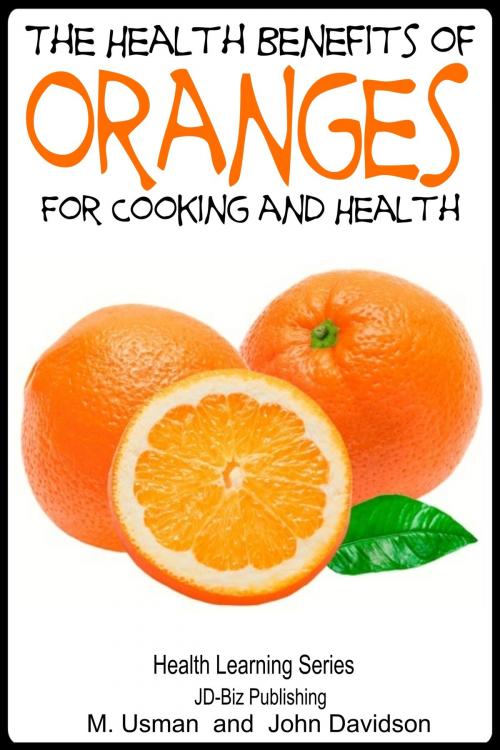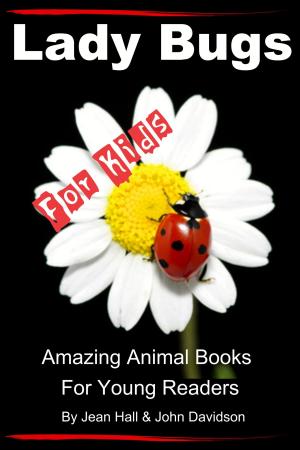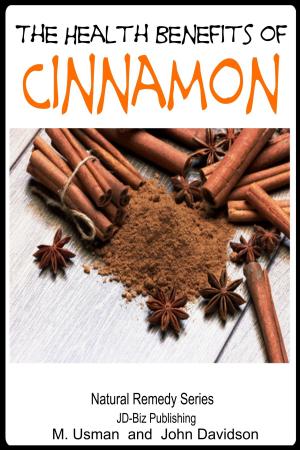Health Benefits of Oranges For Cooking and Health
Nonfiction, Food & Drink, Baking & Desserts, Fruit, Health & Well Being, Health, Healthy Living| Author: | M Usman, John Davidson | ISBN: | 9781310576614 |
| Publisher: | JD-Biz Corp Publishing | Publication: | July 29, 2014 |
| Imprint: | Smashwords Edition | Language: | English |
| Author: | M Usman, John Davidson |
| ISBN: | 9781310576614 |
| Publisher: | JD-Biz Corp Publishing |
| Publication: | July 29, 2014 |
| Imprint: | Smashwords Edition |
| Language: | English |
Health Benefits of Oranges For Cooking and Health
Table of Contents
Getting Started
Chapter # 1: Intro
Chapter # 2: Nutritional Worth
Chapter # 3: Selection and Storage
Chapter # 4: Preparation
Health Benefits
Chapter # 1: Not Just Vitamin C
Chapter # 2: Promotes Cardiovascular Health
Chapter # 3: Immunity Booster
Chapter # 4: Fights Cancer
Chapter # 5: Protection against Arthritis & Muscle-Wasting
Recipes
Chapter # 1: Orange Rosemary Chicken
Chapter # 2: Orange & Beetroot Chopped Salad
Chapter # 3: Orange Drizzle Cake
Conclusion
References
Getting Started
Chapter # 1: Intro
Who doesn’t love the idea of having sweet, juicy, vigorous and vitamin C-packed oranges for breakfast? Athletes eat it whenever they need a quick, natural shot of energy and most of the population enjoys them just for their flavor, not knowing about their health benefits. And this is exactly why this book must be read by all; almost everyone known oranges contain vitamin C but there aren’t many people who know what comes as a result of it. Better yet, there are many other nutrients and health promoting compounds present in oranges that have far-fetched effects on the human body that would drastically increase the daily intake of oranges by the common populace, if found out. But everything needs to be built from the bottom-up and this is exactly what will be done in the forthcoming chapters.
Oranges are spherical fruits belonging to the citrus species consisting of two major types: sweet and bitter. The sweet orange is the one that is generally consumed and is known by its scientific name as Citrus Sinensis whereas the bitter orange is known as Citrus Aurantium. Popular variations of the sweet orange include Navel, Jaffa, Valencia and Blood-oranges which are a hybrid species, more aromatic in flavor, smaller in size and with red hues throughout their flesh. Most people do not get into the classification and to refer to the sweet orange as simply orange. The orange tree is a multi-seasonal, flowering tree growing to a height of 9-10 m; some species have been reported to grow as long as 15 m. Its oval leaves are 4-10 cm long and are alternatively arranged throughout the stem. The bottom of the tree, including the trunk and roots is called rootstick while the fruit bearing part of the tree is known as scion. Almost every variety of sweet oranges contains 10 segments (carpels) and six seeds. The orange fruit has a green color when it is unripe and upon reaching ripeness turns orange to yellow-orange.
The word orange is derived from the Sanskrit word for “orange tree”; the Sanskrit reached the European continent after going through Persian and Arabic derivations. Oranges are believed to be originated thousands of years ago in the Asian region ranging from South of China to Indonesia. Oranges were not cultivated in the Middle Eastern region till the 9th Century and it wasn’t until the 15th Century that they made into Europe, thanks to ethnic groups like Moors and traders like the Portuguese and Italians who voyaged to Asia. From Europe, oranges found their way into the Caribbean islands in the late 15th Century when Christopher Columbus brought the seeds on his voyage to the New World. Spanish explorers brought oranges to Florida & California in the 16th and 18th Century respectively. Currently, some of the largest producers of oranges include Brazil, USA and China with each country producing 18, 8 and 6.5 million tones of oranges annually making orange trees the most cultivated trees in the world.
Coming to the health-promoting side of oranges, it should be known that an orange has over 170 different healthy phytochemicals and more than 60 flavonoids, almost all of which act as strong anti-oxidants & anti-inflammatory bodies. Looking at these qualities it wouldn’t be wrong to relate oranges with the proverb, “an apple a day”! There are countless reasons why oranges fit this, they promote
Health Benefits of Oranges For Cooking and Health
Table of Contents
Getting Started
Chapter # 1: Intro
Chapter # 2: Nutritional Worth
Chapter # 3: Selection and Storage
Chapter # 4: Preparation
Health Benefits
Chapter # 1: Not Just Vitamin C
Chapter # 2: Promotes Cardiovascular Health
Chapter # 3: Immunity Booster
Chapter # 4: Fights Cancer
Chapter # 5: Protection against Arthritis & Muscle-Wasting
Recipes
Chapter # 1: Orange Rosemary Chicken
Chapter # 2: Orange & Beetroot Chopped Salad
Chapter # 3: Orange Drizzle Cake
Conclusion
References
Getting Started
Chapter # 1: Intro
Who doesn’t love the idea of having sweet, juicy, vigorous and vitamin C-packed oranges for breakfast? Athletes eat it whenever they need a quick, natural shot of energy and most of the population enjoys them just for their flavor, not knowing about their health benefits. And this is exactly why this book must be read by all; almost everyone known oranges contain vitamin C but there aren’t many people who know what comes as a result of it. Better yet, there are many other nutrients and health promoting compounds present in oranges that have far-fetched effects on the human body that would drastically increase the daily intake of oranges by the common populace, if found out. But everything needs to be built from the bottom-up and this is exactly what will be done in the forthcoming chapters.
Oranges are spherical fruits belonging to the citrus species consisting of two major types: sweet and bitter. The sweet orange is the one that is generally consumed and is known by its scientific name as Citrus Sinensis whereas the bitter orange is known as Citrus Aurantium. Popular variations of the sweet orange include Navel, Jaffa, Valencia and Blood-oranges which are a hybrid species, more aromatic in flavor, smaller in size and with red hues throughout their flesh. Most people do not get into the classification and to refer to the sweet orange as simply orange. The orange tree is a multi-seasonal, flowering tree growing to a height of 9-10 m; some species have been reported to grow as long as 15 m. Its oval leaves are 4-10 cm long and are alternatively arranged throughout the stem. The bottom of the tree, including the trunk and roots is called rootstick while the fruit bearing part of the tree is known as scion. Almost every variety of sweet oranges contains 10 segments (carpels) and six seeds. The orange fruit has a green color when it is unripe and upon reaching ripeness turns orange to yellow-orange.
The word orange is derived from the Sanskrit word for “orange tree”; the Sanskrit reached the European continent after going through Persian and Arabic derivations. Oranges are believed to be originated thousands of years ago in the Asian region ranging from South of China to Indonesia. Oranges were not cultivated in the Middle Eastern region till the 9th Century and it wasn’t until the 15th Century that they made into Europe, thanks to ethnic groups like Moors and traders like the Portuguese and Italians who voyaged to Asia. From Europe, oranges found their way into the Caribbean islands in the late 15th Century when Christopher Columbus brought the seeds on his voyage to the New World. Spanish explorers brought oranges to Florida & California in the 16th and 18th Century respectively. Currently, some of the largest producers of oranges include Brazil, USA and China with each country producing 18, 8 and 6.5 million tones of oranges annually making orange trees the most cultivated trees in the world.
Coming to the health-promoting side of oranges, it should be known that an orange has over 170 different healthy phytochemicals and more than 60 flavonoids, almost all of which act as strong anti-oxidants & anti-inflammatory bodies. Looking at these qualities it wouldn’t be wrong to relate oranges with the proverb, “an apple a day”! There are countless reasons why oranges fit this, they promote















